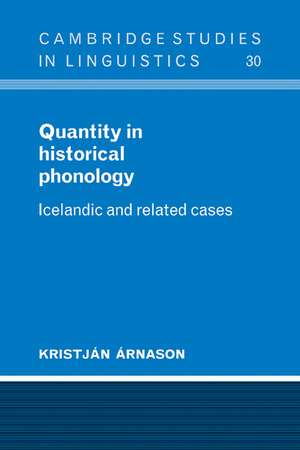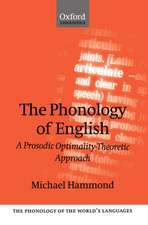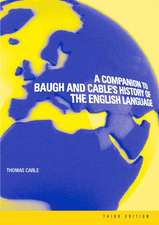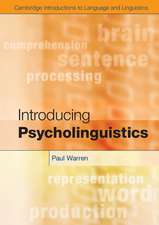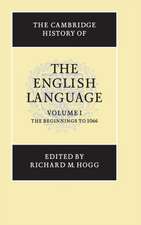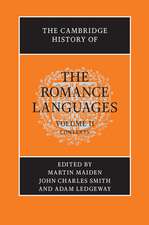Quantity in Historical Phonology: Icelandic and Related Cases: Cambridge Studies in Linguistics, cartea 30
Autor Kristján Árnasonen Limba Engleză Paperback – 10 dec 2008
Din seria Cambridge Studies in Linguistics
-
 Preț: 178.20 lei
Preț: 178.20 lei -
 Preț: 239.36 lei
Preț: 239.36 lei -
 Preț: 176.27 lei
Preț: 176.27 lei -
 Preț: 236.78 lei
Preț: 236.78 lei - 9%
 Preț: 730.86 lei
Preț: 730.86 lei -
 Preț: 290.09 lei
Preț: 290.09 lei -
 Preț: 236.58 lei
Preț: 236.58 lei -
 Preț: 236.05 lei
Preț: 236.05 lei -
 Preț: 328.65 lei
Preț: 328.65 lei -
 Preț: 403.66 lei
Preț: 403.66 lei -
 Preț: 283.79 lei
Preț: 283.79 lei -
 Preț: 325.16 lei
Preț: 325.16 lei -
 Preț: 281.30 lei
Preț: 281.30 lei -
 Preț: 285.93 lei
Preț: 285.93 lei -
 Preț: 282.48 lei
Preț: 282.48 lei -
 Preț: 285.16 lei
Preț: 285.16 lei -
 Preț: 343.43 lei
Preț: 343.43 lei -
 Preț: 319.74 lei
Preț: 319.74 lei -
 Preț: 283.63 lei
Preț: 283.63 lei -
 Preț: 287.48 lei
Preț: 287.48 lei -
 Preț: 391.62 lei
Preț: 391.62 lei -
 Preț: 327.03 lei
Preț: 327.03 lei -
 Preț: 282.10 lei
Preț: 282.10 lei -
 Preț: 285.75 lei
Preț: 285.75 lei -
 Preț: 219.81 lei
Preț: 219.81 lei - 11%
 Preț: 509.10 lei
Preț: 509.10 lei -
 Preț: 220.57 lei
Preț: 220.57 lei -
 Preț: 455.74 lei
Preț: 455.74 lei -
 Preț: 247.08 lei
Preț: 247.08 lei -
 Preț: 222.19 lei
Preț: 222.19 lei -
 Preț: 324.40 lei
Preț: 324.40 lei -
 Preț: 322.29 lei
Preț: 322.29 lei -
 Preț: 399.59 lei
Preț: 399.59 lei -
 Preț: 326.15 lei
Preț: 326.15 lei - 11%
 Preț: 451.14 lei
Preț: 451.14 lei -
 Preț: 415.02 lei
Preț: 415.02 lei - 14%
 Preț: 724.58 lei
Preț: 724.58 lei
Preț: 284.01 lei
Nou
Puncte Express: 426
Preț estimativ în valută:
54.35€ • 56.42$ • 45.32£
54.35€ • 56.42$ • 45.32£
Carte tipărită la comandă
Livrare economică 22 martie-05 aprilie
Preluare comenzi: 021 569.72.76
Specificații
ISBN-13: 9780521103831
ISBN-10: 0521103835
Pagini: 244
Dimensiuni: 152 x 229 x 14 mm
Greutate: 0.36 kg
Editura: Cambridge University Press
Colecția Cambridge University Press
Seria Cambridge Studies in Linguistics
Locul publicării:Cambridge, United Kingdom
ISBN-10: 0521103835
Pagini: 244
Dimensiuni: 152 x 229 x 14 mm
Greutate: 0.36 kg
Editura: Cambridge University Press
Colecția Cambridge University Press
Seria Cambridge Studies in Linguistics
Locul publicării:Cambridge, United Kingdom
Cuprins
1. Introduction; 2. Quantity and stress in Modern Icelandic; 3. Length and quantity in related languages; 4. The development in Icelandic; 5. Explaining the changes; 6. Length and quantity in phonology; Bibliography; Index.
Descriere
This is a study for those interested in Scandinavian languages but it has wider theoretical implications for all historical linguists.
